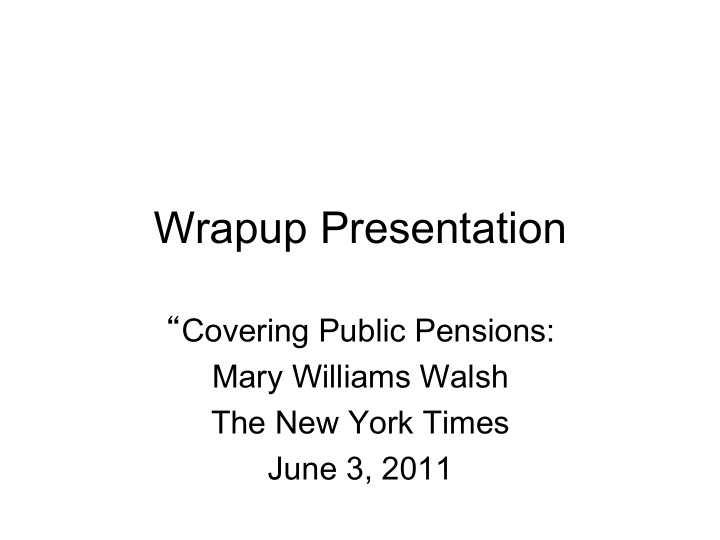



Wrapup Presentation “ Covering Public Pensions: Mary Williams Walsh The New York Times June 3, 2011
The pension plan is underfunded. So what?
Geraldine
Major Stakeholders • Public workers • Public retirees • Taxpayers • Municipal bondholders
Who champions Geraldine ’ s interests? • Securities and Exchange Commission?—only to protect the bond market if there ’ s a finding of fraud • IRS?—limited authority over governmental pensions, and no legal authority over funding • Labor Department?—only oversees company pension plans, not governmental plans • GASB?—they have no enforcement power • State attorneys general?—sometimes get involved, but they represent the state • “ The market ” ?—it ’ s too hard to short municipal bonds • Journalists—can shine a light on unsavory practices, fairness issues, sustainability
No ERISA • There was initially intended to be a second law, called PERISA, but it fizzled out. It ’ s pretty hard to trigger a federal enforcement action because the main federal law doesn ’ t apply. • You don ’ t have to break a law to cause harm. It ’ s possible to cause harm in an attempt to do good.
Mexican debt crisis • No one stole the money • They were trying to do good, to develop the country • They financed it by taking on a lot of debt, and securing it with rising oil prices • Oil prices fell • Pensions—an attempt to do good, secured with stocks—and stocks fell
Is the solution taxing the rich?
Who are the local taxpayers?
Data on states and cities • Municipal Securities Rulemaking Board (MSRB) • Electronic Municipal Market Access (EMMA), fairly new, still expanding content • http://emma.msrb.org/ • Has a tutorial on its site • “ Official Statement ” is a factual overview of the community ’ s finances
Official statements have: • Lists of the ten biggest employers—can see how many are non-profits that pay no taxes • Data on whether the population is shrinking or growing • How is the bond secured, in case there ’ s a dispute? • Description of pension promises • Etc.
Look for discrepancies • Pension data in Official Statement • Pension data in the city or state CAFR • Pension data in the pension fund ’ s CAFR • Pension data in the actuarial valuation—if you have a source who can help you read it • Pension data in fiscal notes
The numbers should reconcile • In New Jersey they did not—SEC action • In San Diego they did not—SEC action • Illinois? • Rhode Island? • Detroit? • California? • Etc.
New Jersey Diverts Billions, Endangering Pension Fund Lead: In 2005, New Jersey put either $551 million, $56 million or nothing into its pension fund for teachers. All three figures appeared in various state documents -- though the state now says that the actual amount was zero.
Audited financial statement
Official Statement, appdx A
Official Statement, appdx D
Can ’ t explain the discrepancy • Contributions are a cash number • Not smoothed • Not amortized • Schedule 2 is normally very good data … • … but the Official Statement must be right, or else the bond market it being given false information
“ Excess Valuation Assets ”
New Jersey fiscal note
Benefit Enhancement Fund
Problem started in 1994 • Unanimous state supreme court order • State ’ s school financing system was unconstitutional • “ Abbott v. Burke, ” filed in 1981 • A need to find hundreds of millions of dollars, for 30 blighted urban school districts, by 1996
Difficult Time • Governor Christine Todd Whitman had campaigned on a promise to cut state income taxes by 30 percent over 3 years • Two weeks before the court ruled, she had just pushed a budget through the legislature • One-third of state spending then went to education • Whitman said she believed the court order could be met “ through a reallocation of existing resources. ”
Where will we find the money?
Actuarial cost methods used • New Jersey had been on “ Entry Age ” • Coopers & Lybrand advised switching to “ Projected Unit Credit ” • The new method is perfectly legal, but it slows down the rate of new money going into the plan • Suspicious legislators held public hearings • Actuaries testified but never answered the questions clearly
Context: the boom years • New Jersey Education Association knew what was happening and sued, unsuccessfully • The stock run-up made it look as if there was plenty of money and the change didn ’ t matter • To pacify the teachers, Gov. Whitman issued a Pension Obligation Bond
Benefit increase in 2001 • Tech bubble had already burst • Fund had suffered significant losses • State looked back to 1999, when the fund was still flush • Market value of assets was $5.3 billion greater than the actuarial value, because of smoothing • State officials grabbed that $5.3 billion difference and treated it as “ found money, ” putting it into the “ Benefit Enhancement Fund ”
From audited financial statements:
Role of the S.E.C. • No legal standing to protect pension plan participants • No legal standing to protect Geraldine • Limited legal standing to protect municipal bond participants • Took action against New Jersey for misleading potential bond buyers about the state ’ s financial condition • Pension fund is still underfunded!
Contact me with questions • Mary Williams Walsh • maryw@nytimes.com • Direct: 212-556-4271 • Follow up if you don ’ t hear back from me
Recommend
More recommend